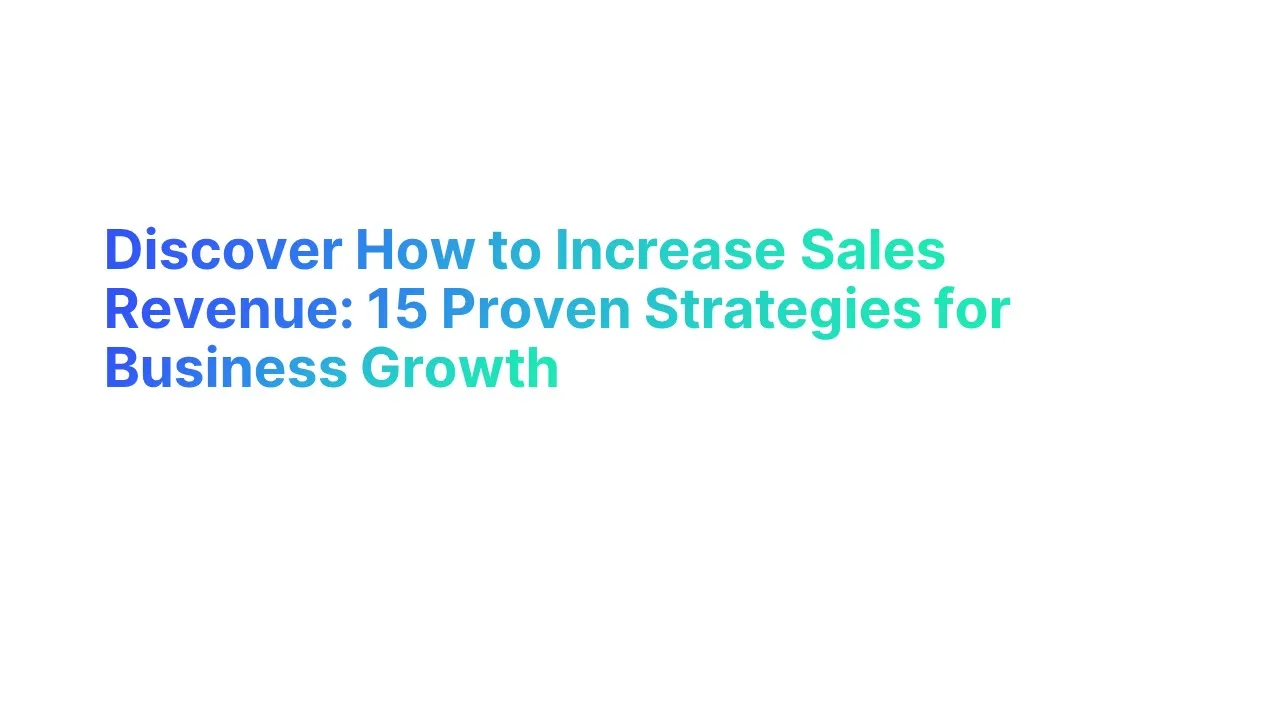An increase in sales revenue refers to a measurable rise in the amount of money generated through sales activities over a specific period. This growth is crucial for business expansion and profitability.
To understand an increase in sales revenue, consider it as an indicator of a company's performance and market demand. For instance, a company reporting a quarterly sales revenue growth from $100,000 to $150,000 has achieved a 50% increase. This significant rise could be attributed to various factors such as enhanced marketing strategies, introduction of new products, or expansion into new markets.
This increase also impacts other financial metrics, bolstering the overall financial health of a business. For example, according to a study by Forbes, companies that focused on increasing sales to existing customers, using strategies like cross-selling and up-selling, saw a revenue increase of 20% annually.
15 Ways to Increase Revenue in Sales

Here’s a list of 15 effective strategies to increase revenue in sales:
Strategy 1: Dynamic Pricing Models
Dynamic pricing models leverage real-time market data to adjust prices based on demand, competition, and customer behavior. This strategy is crucial for maximizing revenue, especially in industries like hospitality, travel, and online retail.
- Adaptability to Market Conditions: Prices adjust in response to competitor pricing strategies, ensuring your offerings remain competitive without sacrificing margins.
- Consumer Behavior Insights: By analyzing purchasing trends, you can tailor prices during peak demand periods, potentially increasing sales revenue by up to 25% according to a McKinsey report.
- Enhanced Profit Margins: Dynamic pricing allows for pricing optimization during different times of the day or week, optimizing sales and profit margins based on customer willingness to pay.
Strategy 2: Sales Team Specialization
Specializing your sales team involves segmenting them by product, market, or customer type, which enhances their expertise and effectiveness in specific areas. This targeted approach not only improves sales efficiency but also increases revenue by delivering more personalized customer interactions.
- Expert Knowledge: Sales representatives become experts in specific areas, increasing their credibility and the quality of customer interactions.
- Increased Customer Satisfaction: Specialized knowledge leads to better matching of customer needs with product offerings, enhancing customer satisfaction and repeat purchases.
- Higher Conversion Rates: According to Salesforce, sales teams that specialize based on industry or product knowledge can see conversion rates improve by up to 15%.
Strategy 3: Geographic Expansion
Expanding into new geographic markets is a significant step for growing your customer base and increasing sales revenue. This strategy involves entering new domestic or international markets that present untapped potential.
- Market Diversification: Reduces dependency on a single market and spreads risk across different regions.
- Access to New Customers: Expands the potential customer base, potentially increasing sales revenue by accessing markets with higher demand for your products.
- Local Adaptations: Tailoring products to meet local tastes and compliance can lead to a higher market penetration rate. For example, companies that adapt their products to local preferences can see a 20% increase in sales revenue, as evidenced in global markets.
Strategy 4: Product Line Extensions
Adding new products or variations to existing lines can attract different customer segments and increase cross-selling opportunities. This approach not only diversifies your product offerings but also stimulates interest and encourages existing customers to make additional purchases.
- Meeting Broader Needs: By offering more options, you meet a wider range of customer needs, which can increase sales revenue from existing customers by appealing to their different preferences.
- Enhanced Market Reach: Each new product variation can appeal to a new customer segment, effectively increasing your market reach and customer base.
- Synergistic Effects: New products can leverage the brand's existing reputation, reducing marketing costs and accelerating the adoption rate. For instance, Apple's introduction of the Apple Watch leveraged its existing brand loyalty to capture a significant share of the smartwatch market quickly.
Strategy 5: Advanced Digital Marketing
Advanced digital marketing employs sophisticated strategies and technologies to target and engage audiences more effectively across various digital platforms. This comprehensive approach enhances brand visibility and drives conversions.
- Targeted Advertising: Using advanced algorithms to target specific demographics with PPC (pay-per-click) campaigns, ensuring ads are seen by potential customers likely to purchase, thus increasing the efficiency of marketing spend.
- SEO and Content Marketing: Optimizing content for search engines to improve organic reach and employing content marketing strategies to establish thought leadership and engage potential customers.
- Social Media Engagement: Leveraging platforms like Instagram and Facebook to run targeted campaigns that not only increase brand awareness but also directly drive sales through integrated shopping experiences.
Strategy 6: Customer Loyalty Programs
Customer loyalty programs incentivize repeat business by rewarding returning customers, thereby enhancing customer retention and boosting sales revenue.
- Rewards for Repeat Purchases: Offering points, discounts, or exclusive offers encourages customers to continue choosing your brand over competitors.
- Personalized Experiences: Using customer data to offer personalized rewards increases the perceived value of the loyalty program, leading to higher engagement and customer satisfaction.
- Data-Driven Insights: Analyzing purchase patterns from loyalty program data can help refine marketing strategies and product offerings, further increasing customer engagement and sales.
Strategy 7: Big Data Utilization
Big data utilization involves collecting and analyzing large sets of data from various sources to inform business strategies and operational improvements. This strategic use of data is crucial for enhancing decision-making and optimizing performance.
- Customer Insights: Gathering and analyzing customer feedback and behavior data to tailor products and services more closely to customer needs.
- Market Trends Analysis: Utilizing predictive analytics to identify and capitalize on market trends, potentially increasing market share and revenue.
- Operational Efficiency: Analyzing operational data to identify inefficiencies and areas for cost reduction, which can indirectly contribute to increased profitability.
Strategy 8: Sales Process Automation
Sales process automation involves using software tools to automate routine sales tasks, thereby increasing efficiency and allowing the sales team to focus on higher-value interactions.
- Lead Management: Automating lead capture and follow-up processes ensures that no potential sales opportunities are lost and that leads are nurtured consistently.
- CRM Integration: Integrating Customer Relationship Management (CRM) systems to streamline all customer interactions and sales processes, providing a seamless flow of information across sales teams.
- Performance Tracking: Automated reporting tools help track sales performance and key metrics, enabling timely adjustments to sales strategies and operations.
Strategy 9: Upselling Premium Products
Upselling premium products involves encouraging customers to purchase higher-end or more expensive versions of the items they are interested in. This strategy not only increases the average transaction size but also enhances customer satisfaction by aligning them with products that better meet their needs.
- Product Training for Sales Staff: Equip your sales team with in-depth knowledge about the benefits of premium products so they can effectively communicate value to customers.
- Targeted Product Recommendations: Implement algorithms on your e-commerce site that suggest premium products based on the customer's browsing history and purchase patterns.
- Bundling Products: Offer premium products in bundles with complementary items at a slightly reduced package price to increase perceived value and encourage purchases.
Strategy 10: Strategic Business Alliances
Forming strategic alliances with other businesses can open up new customer channels and provide mutual benefits through co-marketing efforts or shared technology.
- Co-Marketing Campaigns: Partner with companies that offer complementary products or services to run joint marketing campaigns, broadening your audience reach.
- Shared Technology Platforms: Collaborate on technology development for better customer insights and shared service delivery platforms to enhance customer experience.
- Cross-Promotional Offers: Create offers that involve products from both partners, incentivizing each customer base to engage with both brands.
Strategy 11: Time-Limited Promotions
Time-limited promotions create urgency, encouraging customers to make purchases quickly to take advantage of a special offer before it expires. This is an effective way to boost sales in a short period.
- Flash Sales: Announce short, unexpected sales that encourage immediate purchases by providing significant discounts for a limited time.
- Seasonal Discounts: Leverage holidays and seasons with high shopping activity by offering time-sensitive promotions aligned with these periods.
- Limited Edition Releases: Offer exclusive or limited edition products for a short duration to create exclusivity and urgency.
Strategy 12: E-commerce Optimization
Optimizing your e-commerce platform ensures that the online shopping experience is seamless and efficient, thereby improving conversion rates and customer retention.
- User Experience (UX) Design: Improve the website layout, speed, and navigation to ensure it is user-friendly and appealing, reducing bounce rates and abandoned carts.
- Mobile Optimization: Ensure your e-commerce site is fully optimized for mobile devices, considering the increasing prevalence of mobile shopping.
- Checkout Process Simplification: Streamline the checkout process to minimize steps and required information, incorporating multiple payment options to accommodate different customer preferences.
Strategy 13: Flexible Financing Options
Offering flexible financing options can make it easier for customers to make purchases by reducing the upfront financial burden, thereby increasing sales conversions and customer loyalty. Optimizing pricing strategies through flexible terms not only attracts more customers but also aligns with a competitive pricing strategy that can adapt to market needs.
- Buy Now, Pay Later Plans: Implement plans that allow customers to purchase products immediately and pay in installments over time. This is particularly effective for higher-priced items, making it easier for customers to spend more money without immediate financial pressure.
- Subscription Models: For regular purchases or services, offer subscription plans that spread the cost over time but ensure steady revenue for your business, helping with customer acquisition and retention of loyal customers.
- Leasing Options: Provide leasing options for expensive products, which can be especially appealing in B2B environments where clients prefer to manage cash flow and reduce capital expenditure.
Strategy 14: Targeted Content Marketing
Content marketing targeted towards the specific needs and stages of your customer's journey can significantly increase engagement and conversion rates by providing valuable information that supports their purchase decisions. Good customer service through responsive content delivery can enhance customer satisfaction.
- Educational Blog Posts: Create detailed blog posts that answer common customer questions related to your products or industry, establishing your brand as a thought leader within your target market.
- How-to Videos: Produce video content that shows how to use your products or solve specific problems, enhancing user engagement and product desirability.
- Personalized Email Campaigns: Use customer data to send personalized content that caters to the interests and past behavior of subscribers, improving open rates and conversions.
Strategy 15: Subscription-Based Services
Transforming one-time purchases into recurring revenue through subscription-based services provides a consistent revenue stream and deepens customer relationships, offering exceptional customer service through regular and dependable product or service delivery.
- Membership Programs: Offer memberships that provide regular product updates, exclusive services, or ongoing support, which can enhance customer retention and foster a community of loyal customers.
- Renewable Subscriptions: For consumables or frequently used services, set up renewable subscriptions that automatically replenish products or extend services, ensuring convenience and continuity for customers.
- Tiered Subscription Levels: Create different levels of subscription plans that cater to varying customer needs and budgets, allowing customers to choose the plan that best fits their requirements.
How to Increase Revenue from Existing Customers

Increasing revenue from existing customers is a highly efficient way to grow your business, as it typically costs less to sell to someone who has already purchased from you than to a new customer. Here are several strategies you can implement to maximize revenue from your current customer base:
1. Implement a Loyalty Program
A loyalty program rewards repeat customers, encouraging them to continue doing business with you. Benefits can include discounts, exclusive offers, or access to special products or events. This not only increases the frequency of purchases but also fosters a deeper sense of loyalty among customers.
2. Upsell and Cross-Sell Products
Upselling involves encouraging customers to purchase a more expensive item or upgrade than what they are currently considering. Cross-selling suggests complementary products that add value to their original purchase. Both strategies increase the average transaction size.
- Effective Training: Ensure your sales team understands how to introduce upsells and cross-sells naturally in their conversations.
- Relevant Recommendations: Use customer purchase history and preferences to make relevant product suggestions.
3. Enhance Customer Service
Exceptional customer service can transform one-time buyers into repeat customers. Make sure your customer service is responsive, helpful, and proactive.
- Customer Feedback: Regularly collect and analyze feedback to improve service and address any recurring issues.
- Personal Touch: Customize interactions to make customers feel valued; personalized communications can significantly impact customer satisfaction and retention.
4. Offer Subscription Services
If applicable, convert one-time purchases into subscriptions. This ensures a steady revenue stream and simplifies the repurchase process for the customer.
- Tiered Options: Provide different levels of subscription plans to cater to various needs and budgets.
- Flexible Terms: Allow customers to modify or cancel their subscriptions without significant penalties to enhance trust and satisfaction.
5. Utilize Data Analytics
Leverage customer data to better understand buying behaviors, preferences, and patterns. This insight can help you tailor your marketing efforts, product development, and sales strategies to better meet the needs of your existing customers.
- Segmentation: Group customers based on their behaviors and preferences for more targeted marketing.
- Predictive Analytics: Use analytics to predict future buying behaviors and tailor your interactions accordingly.
6. Improve Product or Service Offerings
Regularly updating and improving your products or services based on customer feedback and market trends keeps your offerings relevant and desirable, encouraging repeat business.
- Innovation: Continuously introduce new features or products that meet the evolving needs of your customers.
- Quality Assurance: Maintain high quality in your offerings to ensure customer satisfaction and reduce churn.
7. Create Exclusive Offers
Make your existing customers feel special by offering them exclusive deals, early access to new products, or special bundled pricing. These offers can increase perceived value and encourage more frequent purchases.
- Time-Limited Promotions: Offer promotions exclusive to returning customers to encourage them to make a purchase decision quickly.
Concluding Thoughts
In conclusion, the strategies outlined in "Discover How to Increase Sales Revenue: 15 Proven Strategies for Business Growth" offer a comprehensive roadmap for any business aiming to elevate its revenue and ensure sustainable growth. From leveraging dynamic pricing models and specializing sales teams to expanding geographically and innovating through digital marketing, each approach provides actionable steps tailored to enhance performance and profitability.
By implementing these tactics, businesses can optimize their operations, engage more effectively with customers, and ultimately drive significant increases in sales revenue. The key to success lies in consistently applying these strategies while adapting to market changes and customer feedback to remain competitive in a dynamic business environment.





.webp)


